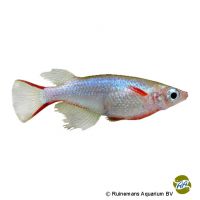Daisy's Ricefish (Oryzias woworae)
| Daisy's Ricefish Oryzias woworae | |
|---|---|
| Name | Daisy's Ricefish |
| Name Lat. | Oryzias woworae |
| Family | Ricefishes |
| Family lat. | Adrianichthyidae |
| Order | Needle Fishes |
| Order lat. | Beloniformes |
| Origin | Southeast Asia |
| Habitat | Forest streams |
| Diet | Omnivore |
| pH | 6.0-7.5 |
| Behavior | Peaceful |
| Keeping | Group |
| Care Level | Easy |
| Reproduction | Egg scatterer |
| Breeding | Moderately difficult |
| Life Span | 3-4 years |
| Protection | No |
| Metric Units | |
| Size | 3 cm |
| Temperature | 23-27 °C |
| Hardness | 5-15 °dH |
| Aquarium | 50 l |
| US Units | |
| Size | 1.2" |
| Temperature | 73-81 °F |
| Hardness | 89-267 ppm |
| Aquarium | 15 gal |
Distribution and habitat
The Sulawesi Magnificent Rice Carpets are found exclusively (endemically) on the island of Muna, southeast of Sulawesi (Indonesia). They live in shady forest streams with clear water and muddy-sandy soils, partly covered with abundant fallen leaves.
Maintenance
The aquarium should have a dense border planting, with some roots, branches and stones that serve as hiding places. A sandy substrate covered with some foliage (sea almond tree, oak) and soft to medium hard, slightly acidic water and a weak current is ideal
No ammonia, ammonium and nitrite should be detectable, the nitrate value should not exceed 100 mg/l. To ensure the water quality and the oxygen content, a filter adapted to the aquarium size and a heater are required, as well as lighting for the species-appropriate day-night rhythm of the animals.
Diet
The food offer consists of live or frozen cyclops, daphnia, artemia, microworms, etc., supplemented with high-quality dry food for nano fish with a high vegetable content (spirulina). Not too fine seawater plankton (frozen or preserved) and seawater copepods (live) are also gladly accepted
It is advisable to feed small portions daily. Only as much should be fed as is eaten immediately (in a maximum of 10 minutes). A regular and varied diet promotes health and increases resistance.
Behaviour and compatibility
These small and swimming fish are completely peaceful and should be kept in a group of at least 8-10 animals. They are well suited for any nano aquarium and can be easily socialized with other small and peaceful fish as well as shrimp (Caridina, Neocaridina).
Basically, only compatible fish species with similar demands on water conditions and water temperature should be socialized.
Sex dimorphism
The slimmer males are much more colorful and have larger dorsal and anal fins than the rounder females. With some experience, the sexes can be distinguished by their genital papilla, which is tubular in the male and bilobed in the female.
Reproduction and breeding
Mating usually takes place in the morning hours after an intense courtship, during which the male entwines the female. The eggs, 10-20 pieces, stick to the abdomen of the female (spawning cluster) and are stripped over water plants only after some time. This process may repeat for several days. After 1-3 weeks the fry hatch, which grow very slowly
During the first weeks the fry must be fed several times a day with infusoria or a commercial liquid rearing food for egg-laying fish. In community tanks breeding is hardly possible, because the fry are easy prey
Important
They show their most beautiful coloration by feeding on live food.
The foliage (sea almond tree, oak, etc.) enriches the water with humic substances, naturally lowers the pH and, when rotting, promotes the development of microorganisms, which are a valuable secondary food source.
The well-being of the fish should be monitored regularly. Temperature should be checked daily, pH, hardness and nitrate levels at least every 14 days. Regular partial water changes are recommended, even when contaminant levels have not yet reached the upper limit. Sudden changes in water quality should be avoided. Newly introduced fish must be accustomed slowly to the water in the aquarium.
Further literature can be found in your pet store.
References
Text: Werner Winter; Image: Ruinemans Aquarium B.V.
Source: BMELV (1998): Tierschutzgutachten - Haltung von Zierfischen (Süßwasser); ENGELMANN (2005): Zootierhaltung - Tiere in menschlicher Obhut: Fische, Verlag Harri Deutsch
- Gemäß § 21 Abs. 5 Tierschutzgesetz idgF
